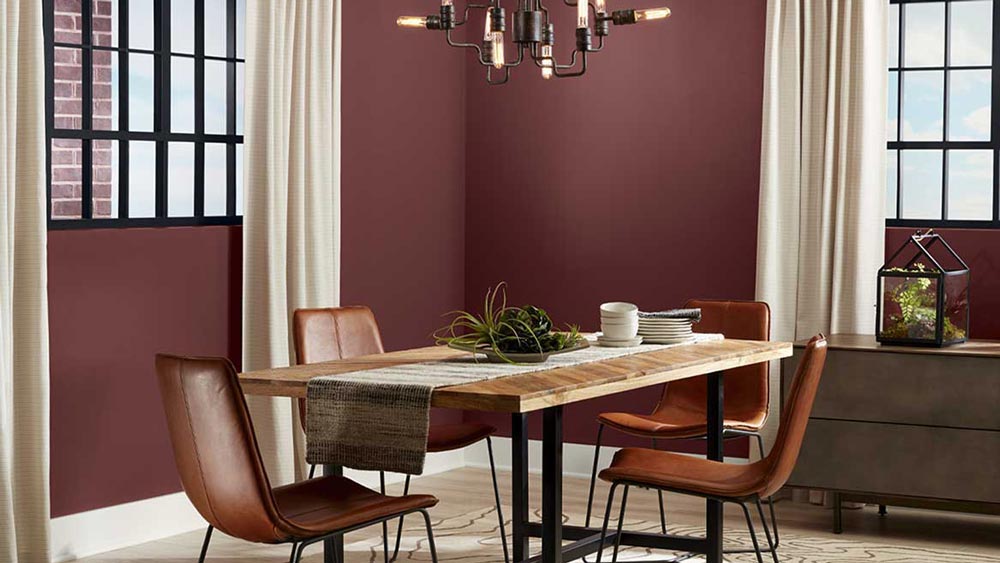Crushed Velvet (2076-10), Benjamin Moore
The 2023 Color of the Year: Viva Magenta!
After several years of uncertainty and melancholy, experts say it’s time to ditch gloomy gray and bring lively, vibrant color into our lives and our homes.
“In this age of technology, we look to draw inspiration from nature and what is real,” suggests Leatrice Eiseman, the executive director of the Pantone Color Institute. “Viva Magenta descends from the red family and is inspired by the red of cochineal, one of the strongest and brightest [dyes] the world has known.”
Apply it to walls, and magenta will create a space that’s buzzing with energy. Or use it sparingly in accents, like vases or throw pillows to add a touch of cheer to a neutral palette. Not sure how this bold tone would play in a log or timber home? Try one of our softer, earthier suggestions.
PermaChink LifeLine Ultra 7 Rustic Gray stain with a LifeLine Advance gloss topcoat. Log Home Care was the applicator on the project. Photo courtesy of Wayne Bell/Log Home Care and PermaChink
Stain Shades
Color has the power to influence, and that’s especially true in our homes — even ones made of exposed wood.
“There’s a trend of darker exterior shades with very light interiors,” says Nadia O’Hara, advertising manager for PermaChink Systems, a leading manufacturer of stains and sealants for log, timber and wood homes. “For instance, we are seeing a lot of gray and white, but when it’s on the outer walls, it’s a very dark gray — like a charcoal. And when it’s inside, it’s a pale gray or pickled white. Dark brown exteriors with natural interiors are also quite popular. But the key is that the color be transparent so you can still see the wood grain come through.”
While neutrals and wood tones remain strong, color has its place. PermaChink produces a line of unexpected bold shades, such as midnight blue, garnet red and evergreen, that were originally formulated for the European market, but have found their way into North American log and timber homes. “These shades are particularly attractive on small cabins and cottages,” Nadia says. “They bring out the character.”
Mixing shades and colors is another trend that’s catching on. “Years ago, when a builder had a 3,000-square-foot log house, he’d order one stain color to coat the whole thing,” Nadia says, “But now, we get orders for 1,000 square feet of one color, 500 square feet of another, etc. People are staining great rooms in one shade, bedrooms in another, ceilings in yet another. Mixing colors is very popular now.”

Reclaimed Wood
It only makes sense that log and timber homeowners love the look of reclaimed wood. This sustainable, stylish product adds an instant infusion of character and patina to new houses and feels right at home among the natural beauty of logs and timbers. Sourced from places like old barns, railroad trestles, historic buildings and other storied structures, reclaimed wood brings a touch of history to any space. In log homes, reclaimed wood is a gorgeous choice for floors, cabinets, islands and other accents. In timber homes, the ceiling’s the limit — literally. Apply it anywhere from the floor to interior and exterior walls to the ceiling and structure itself. Sometimes reclaimed wood can be tricky to source and expensive to apply in large quantities. Companies like Colorado Timberframe or Big Cabin Log & Timber offer nuanced finishes that re-create the reclaimed look on newer logs and timbers but with greater affordability and availability.
Centennial Timber Frames photo by Heidi Long.
Fire-tower Design
1. Views are guaranteed. After years of climbing the corporate ladder, homeowners Bick and Bonnie Smith were eager for a new view from the top. They partnered with architect Scott Elden of Montana Creative and Mike Koness, founder of Centennial Timber Frames, to design and build their 35-foot-high perch above the trees in Montana. “It turned out to be a pretty sweet little fort,” Bick says with a laugh.
2. Construction is super sturdy. These multi-story towers jutting from the treetops can take a beating from Mother Nature, so they are built to withstand the worst she can throw at them. Knowing the Smiths’ tower would need to endure the strain of high winds, Mike Koness and his crew reinforced the 30-inch Douglas fir timbers with steel brackets and X-cross beams then secured them to the rock foundation 20 feet below the surface. Not only do these materials fortify the structure, the wood, steel and stone are all on full, glorious display.
3. Open-concept plans are standard. True to their historical roots, fire-tower layouts are wide-open spaces with few internal walls as obstructions. Not only does this afford the aforementioned 360-degree views, it allows substantial cross-ventilation to capture mountaintop or coastal breezes.
4. It’s a home like nothing else. For those who shun cookie-cutter design, you’d be hard-pressed to find another fire-tower house on the block. “Growing up in the [Blue Ridge] mountains, one was very familiar with the National Park Service and its buildings’ ‘Parkitecture’ style. This was the inspiration behind the look of our home,” explains Jeffery Caudill, the architectural mastermind behind Dobie Mountain Lookout — the fire-tower-inspired home he designed for himself and his wife.















